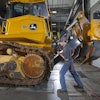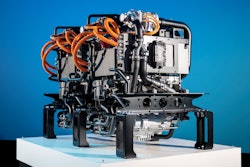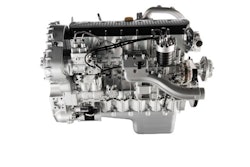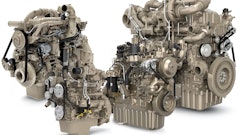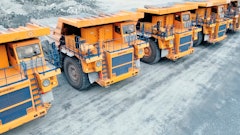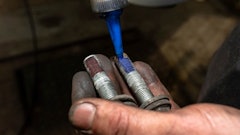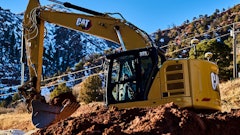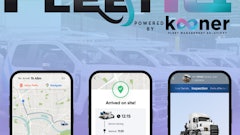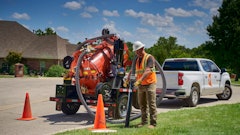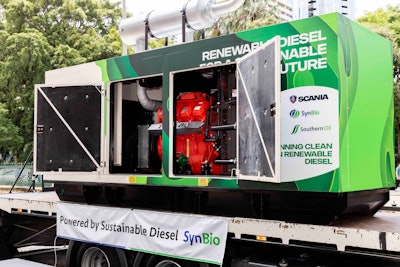
Interest in alternative and renewable fuel options continues to increase in the heavy equipment industries as manufacturers and end users look to decrease their environmental footprint.
“For years, petroleum-based fuels have been the industry standard, primarily due to the lack of acceptable, cost-effective and reliable alternatives,” says Michael Lefebvre, manager, Global Marketing Support at John Deere Power Systems (JDPS). “However, with growing interest in sustainable energy, alternative fuels are becoming more widely adopted and readily available.”
While some fuels, like hydrogen, are still in the testing phases, others such as renewable diesel and propane have been used in various capacities for several years and are seeing increased use and application capabilities.
The Propane Education & Research Council (PERC), for instance, announced at The Work Truck Show 2020 the development of a Class 8 truck engine capable of running on propane. Propane is often thought of as a fuel for use in lawn mowers or other small equipment. But PERC and manufacturers in the heavy equipment space have been working to increase the applications in which this fuel can be used.
Investigating All Options
Most agree that no one technology or fuel source will be the solution. As such, engine manufacturers and OEMs are investigating a wide array of options, including hydrogen, propane and natural gas. Cummins Inc., for instance, has announced further partnerships and investments in hydrogen technology. It also received two U.S. Department of Energy (DOE) awards in August to develop hydrogen fuel cell powertrains. This work is in addition to its development of electric-powered solutions, as well as natural gas and diesel engines.
JCB Develops Hydrogen Fueled Excavator
 JCB's 220X excavator is powered by a hydrogen fuel cell and has been undergoing rigorous testing at the company's quarry proving grounds.JCB
JCB's 220X excavator is powered by a hydrogen fuel cell and has been undergoing rigorous testing at the company's quarry proving grounds.JCB
Alternative fuels play an important role in the wider context of Rolls-Royce Power Systems’ initiatives and its PS2030 – Pioneering Solutions corporate strategy. “The overarching goal of the strategy is to provide answers to the increasing challenges posed by climate change and the rapidly growing societal demands for energy and mobility by pushing decarbonized solutions,” explains Peter Riegger, vice president Power Lab at Rolls-Royce Power Systems.
The PS2030 strategy is composed of three main pillars:
- strengthening and expanding the core business and expanding Power Systems’ market position;
- evolving into a complete solutions provider;
- expanding life-cycle services.
“The transformation from an engine manufacturer into a provider of integrated solutions has a strong focus on climate-neutral and sustainable solutions, which is to be achieved by integrating different renewable energy sources. On the path to net-zero emissions, Power Systems is open to all kinds of technologies,” says Riegger.
 Through its Power-to-X process, Rolls-Royce Power Systems aims to create fuels from renewable sources for a variety of applications.Rolls-Royce Power Systems
Through its Power-to-X process, Rolls-Royce Power Systems aims to create fuels from renewable sources for a variety of applications.Rolls-Royce Power Systems
Riegger says methane from power-to-gas processes offers numerous benefits compared with other Power-to-X options because the production processes are less complex and deliver significantly higher levels of efficiency, which has a positive impact on production costs. A further benefit is the trouble-free, successive replacement of fossil-based natural gas by compressed or liquid methane from renewable energy sources. This enables existing gas networks and applications to still be used without the need for expensive and time-consuming modifications.
“Firstly, gas-based technologies are well developed and are used in millions of applications. Secondly, there is an extensive and high-capacity infrastructure of existing natural gas networks and storage facilities available, with which fluctuations in the supply of renewable energies can be compensated for, large amounts of energy stored and energy consumption peak loads absorbed,” says Riegger. “Vehicles powered with gas from renewables, as a supplement to e-mobility, can make a major contribution to the energy transition.”
Synthetic Fuels Offer Possibilities
Sometimes referred to as gaseous fuel, synthetic fuel is made from syngas — a mixture of carbon monoxide and hydrogen — created by the gasification of solid feedstocks such as biomass, coal or reformed natural gas.
 The Natural Gas configuration of the Cursor X concept can provide many of the same benefits as a traditional natural gas engine.FPT Industrial
The Natural Gas configuration of the Cursor X concept can provide many of the same benefits as a traditional natural gas engine.FPT Industrial
Bosch also believes synthetic fuels made from renewable sources will be a part of the future fuel mix for mobile applications. It says there are many benefits available, including their ability to be used in today’s infrastructure and engines, as Rolls-Royce also points out. And by making the fuels from renewable sources, they are a more climate-neutral option than some other fuel types.
Rolls-Royce Supporting Development of Alternative Fuels
Synthetic fuels can also be used in various applications, including heavy-duty vehicles and equipment. Lefebvre says synthetic fuels could be an option for use in John Deere equipment as long they meet current fuel standards such as ASTM D975, EN 590 or EN15940.
While it is already possible to make synthetic fuels, there is work yet needed to make them a more viable option for the market. As Bosch points out, making the fuel is still a costly process. The fuels will become more affordable when production capacities are expanded and the cost of electricity generated from renewable sources comes down.
7 Reasons Renewable Synthetic Fuels will be Part of Tomorrow’s Mobility Mix
Making Use of Existing Engine Technology
ClearFlame Engine Technologies is currently developing technology that can be adapted to existing diesel engine platforms to enable the use of decarbonized fuels such as ethanol or small-molecule synthetic fuels like methanol. It allows engines to still operate the diesel engine cycle and preserve all the performance and fuel economy benefits of that engine cycle, explains Dr. BJ Johnson, CEO and co-founder. “You can keep the performance without the emissions challenges, or the long-term fuel cost and carbon concerns associated with petroleum diesel fuel.”
 The level of change required to adapt a diesel engine platform to a ClearFlame-enabled engine is similar to those done today for propane or natural gas engines.ClearFlame Engine Technologies
The level of change required to adapt a diesel engine platform to a ClearFlame-enabled engine is similar to those done today for propane or natural gas engines.ClearFlame Engine Technologies
Adjustments are also made to the air-fuel ratio that enable the use of a simplified aftertreatment. “We can use three-way catalysis to handle the NOx emissions instead of the SCR systems that are used today,” says Blumreiter. “That allows not only drastically lower emissions but also lower costs to meet next-generation emissions standards.”
ClearFlame Achieves Successful Test Results Using Decarbonized Fuels
ClearFlame will work with both engine manufacturers and OEMs to integrate the technology. The hardware changes needed are fairly simple, making it easy to integrate. The level of change required to adapt a diesel engine platform to a ClearFlame-enabled engine is similar to those done today for propane or natural gas engines. “You’re keeping 80% to 90% of the engine parts the same, the engine block doesn’t change,” Johnson says. Using liquid fuels simplifies the changes that are needed to adapt the overall vehicle, as well.
The company recently received a Phase II grant from the DOE’s Small Business Innovation Research (SBIR) program which will help support further research and development efforts. ClearFlame is currently demonstrating the technology on a Cummins X15 engine and the DOE grant will help advance that demonstration work and move the technology more toward a final product.
Diesel still has its place
Although the amount of fuel options is increasing, “diesel still has a long life ahead,” says Lefebvre.
“Even with the growing electrification market, diesel (and diesel engines) will still have a significant role to play,” he notes. “The demands of the off-highway market will continue to remain the same — which requires the energy density that comes from diesel and is not currently available from most alternative fuels.”
Lefebvre believes the role of diesel use will likely evolve once smaller applications can meet the same performance requirements with alternative systems. “However, diesel will likely continue to be the main energy source in heavy-duty applications," he adds.
Biodiesel and renewable diesel offer customers the ability to still take advantage of the power benefits of diesel while also enabling opportunities to reduce emissions.
Among the variety of alternative fuel options currently available, JDPS considers biodiesel and renewable diesel to be the alternative fuels that can be integrated into heavy equipment. “Currently, we believe biodiesel and renewable diesel fuel to be the most viable alternatives to diesel fuel for heavy-duty off-highway engines," says Lefebvre.
The biggest advantages of biodiesel and renewable diesel is their renewability, says Lefebvre, as they are made from materials such as plants and cooking oils. He notes that pure biodiesel (B100) is nontoxic, biodegradable and suitable for use in sensitive environments.
 Scania has supplied a 16L engine for testing in Australia which operates on renewable diesel fuel made from waste plastic, old vehicle tires, agricultural and forestry waste, as well as biosolids.Scania AB
Scania has supplied a 16L engine for testing in Australia which operates on renewable diesel fuel made from waste plastic, old vehicle tires, agricultural and forestry waste, as well as biosolids.Scania AB
Lefebvre also notes that renewable diesel is a hydrocarbon fuel like petroleum diesel, so it can offer many of the same benefits. However, its advantage over petroleum diesel is that it has lower greenhouse gas (GHG) emissions on a well-to-wheels basis. “John Deere recognizes the importance of biofuels to its customers and to the environment,” he says. “It’s the right thing to do from a long-term economic standpoint, as well as environmental, energy security and rural development standpoints.”
Riegger says that in the near future, diesel and gas engines may no longer be the sole source of drive and power energy, but they will still play an important role as part of advanced systems technology. Because of this, he says combustion engines remain a core part of the business.
“The energy density of batteries is still no match to that of diesel fuel. It is thus unrealistic that the combustion engine will become obsolete in many applications at short notice,” Riegger says. “But as we’ve seen, that doesn’t mean the combustion engine cannot become decarbonized: synthetic fuels made from captured CO2 with the use of electricity from renewable sources may play a salient role in that regard.
“With environmental and climate friendly synthetic Power-to-X fuels, the combustion engine may have a brighter and longer lasting future than many currently expect," he continues. "We see climate change and the ensuing trend towards decarbonization as [an opportunity] for our MTU technology and continue to offer customers the best solutions in terms of low emissions, fuel consumption, performance and resilience.”



